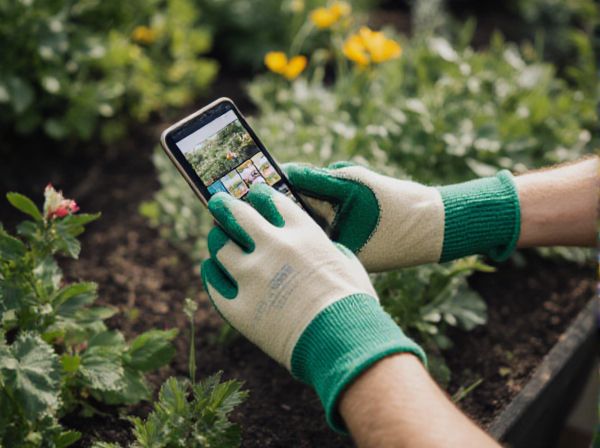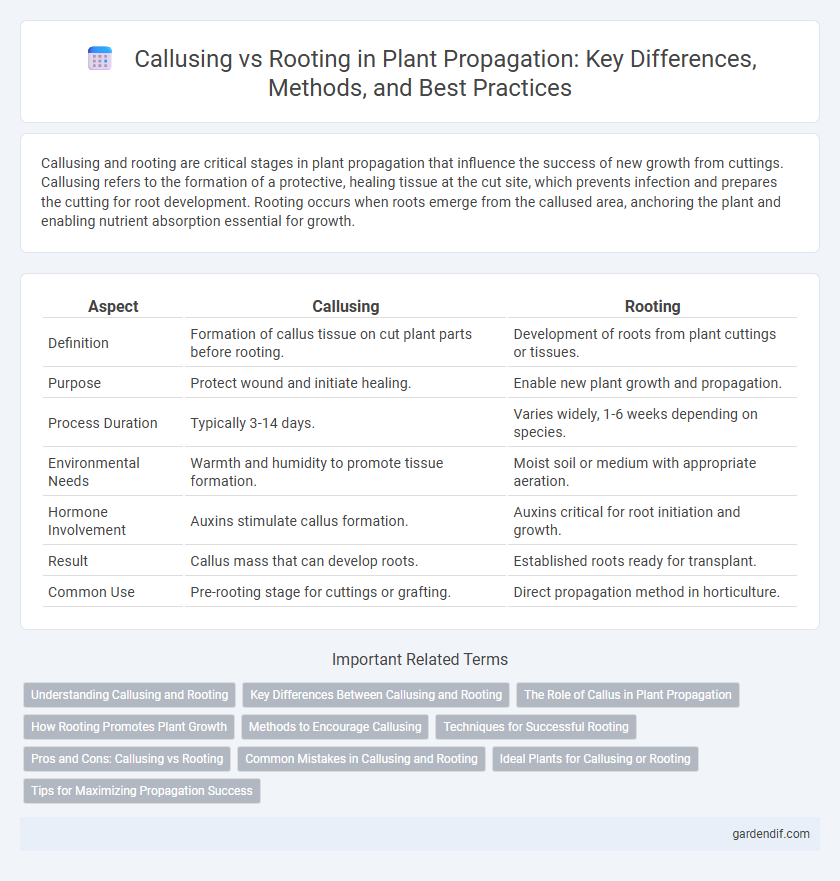
Callusing vs Rooting Illustration
Callusing and rooting are critical stages in plant propagation that influence the success of new growth from cuttings. Callusing refers to the formation of a protective, healing tissue at the cut site, which prevents infection and prepares the cutting for root development. Rooting occurs when roots emerge from the callused area, anchoring the plant and enabling nutrient absorption essential for growth.
Table of Comparison
| Aspect | Callusing | Rooting |
|---|---|---|
| Definition | Formation of callus tissue on cut plant parts before rooting. | Development of roots from plant cuttings or tissues. |
| Purpose | Protect wound and initiate healing. | Enable new plant growth and propagation. |
| Process Duration | Typically 3-14 days. | Varies widely, 1-6 weeks depending on species. |
| Environmental Needs | Warmth and humidity to promote tissue formation. | Moist soil or medium with appropriate aeration. |
| Hormone Involvement | Auxins stimulate callus formation. | Auxins critical for root initiation and growth. |
| Result | Callus mass that can develop roots. | Established roots ready for transplant. |
| Common Use | Pre-rooting stage for cuttings or grafting. | Direct propagation method in horticulture. |
Understanding Callusing and Rooting
Callusing and rooting are crucial stages in plant propagation that influence successful plant development. Callusing involves the formation of a protective tissue layer over a cut or wounded area, preventing infection and preparing the site for root initiation. Rooting is the process where new roots emerge from the callused tissue, enabling nutrient uptake and establishing the cutting as an independent plant.
Key Differences Between Callusing and Rooting
Callusing involves the formation of a protective layer over a wounded plant area, preventing infection and moisture loss, while rooting is the development of new roots from a plant cutting to enable nutrient absorption. Callusing precedes rooting by creating a safe zone where roots can initiate, but does not itself result in root growth. Rooting requires optimal conditions such as humidity, temperature, and hormone application to promote root emergence and successful plant propagation.
The Role of Callus in Plant Propagation
The callus plays a critical role in plant propagation by forming a protective layer of undifferentiated cells at the cut site, which prevents infection and water loss. This callus tissue serves as the foundation for root initiation, facilitating the development of new roots in the rooting phase. Successful propagation depends on the timely transition from callusing to rooting, ensuring healthy and vigorous plant growth.
How Rooting Promotes Plant Growth
Rooting promotes plant growth by establishing a strong root system that efficiently absorbs water and nutrients, essential for healthy development and increased biomass. Rooting also enhances stability, allowing plants to anchor firmly in the soil and resist environmental stressors like wind and drought. Compared to callusing, which primarily protects the plant wound, rooting directly supports sustained growth and nutrient uptake essential for plant vigor.
Methods to Encourage Callusing
Encouraging callusing in plant propagation involves maintaining a warm, dry environment with temperatures between 21-29degC (70-85degF) to prevent rot and promote tissue healing. Applying rooting hormone powders containing auxins like indole-3-butyric acid (IBA) or naphthaleneacetic acid (NAA) accelerates callus formation and increases cutting success rates. Using well-draining mediums such as perlite, vermiculite, or sterile sand helps retain moisture without waterlogging, optimizing callusing conditions before rooting occurs.
Techniques for Successful Rooting
Successful rooting techniques involve using hormone rooting powders or gels to stimulate root growth and creating optimal environmental conditions such as high humidity, consistent moisture, and indirect light. Selecting healthy cuttings with at least two nodes and removing lower leaves reduces moisture loss and encourages root development. Employing methods like bottom heat or misting systems further enhances rooting success by maintaining ideal temperature and hydration levels.
Pros and Cons: Callusing vs Rooting
Callusing promotes wound healing and reduces rotting risk in cuttings, making it ideal for plants sensitive to pathogens, but it requires extra time and controlled humidity. Rooting directly encourages root development and accelerates propagation, yet it increases susceptibility to infections and desiccation without proper care. Choosing between callusing and rooting depends on the plant species' tolerance and the grower's environmental control capabilities.
Common Mistakes in Callusing and Rooting
Common mistakes in callusing include overwatering, which causes stem rot, and failing to maintain proper humidity levels, resulting in incomplete callus formation. In rooting, insufficient use of rooting hormones and inadequate soil aeration often lead to poor root development and increased fungal infections. Ignoring the appropriate environmental conditions such as temperature and light intensity significantly reduces propagation success rates.
Ideal Plants for Callusing or Rooting
Succulent species such as Echeveria and Jade plants are ideal for callusing due to their thick, fleshy leaves that minimize moisture loss during the healing phase. Herbaceous plants like coleus and tomato are perfect candidates for rooting because their softer stems readily develop roots in water or soil mediums. Woody plants, including hibiscus and roses, benefit from semi-hardwood cuttings which require a balance between callusing and rooting stages to ensure successful propagation.
Tips for Maximizing Propagation Success
To maximize propagation success, ensure callusing cuts by placing them in a warm, dry environment with good airflow to prevent rot and promote healing. For rooting, maintain consistent moisture using a misting system or humidity dome while providing bottom heat between 70-75degF to stimulate root development. Using rooting hormones like auxins on fresh cuts can significantly increase the likelihood of successful root formation.
Callusing vs Rooting Infographic

 gardendif.com
gardendif.com